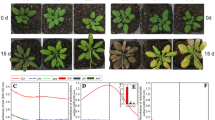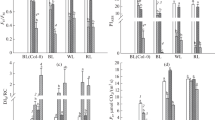Abstract.
The npq1 mutant of Arabidopsis thaliana (L.) Heynh. has no xanthophyll cycle due to a lack of functional violaxanthin de-epoxidase. Short-term exposure (<2 days) of detached leaves or whole plants to the combination of high photon flux density (1,000 µmol m–2 s–1) and low temperature (10 °C) resulted in PSII photoinhibition which was more acute in npq1 than in the wild type. This increased photosensitivity of npq1 at chilling temperature was attributable to the inhibition of nonphotochemical energy quenching (NPQ) and not to the absence of zeaxanthin itself. In contrast to PSII, PSI was found to be phototolerant to chilling stress in the light in both genotypes. In the long term (10–12 days), PSII activity recovered in both npq1 and wild type, indicating that A. thaliana is able to acclimate to chilling stress in the light independently of the xanthophyll cycle. In npq1, photoacclimation involved a substantial reduction of the light-harvesting pigment antenna of PSII and an improvement of photosynthetic electron transport. Chilling stress also induced synthesis of early light-induced proteins (ELIPs) which, in the long term, disappeared in npq1 and remained stable in the wild type. In both genotypes, photoacclimation at low temperature induced the accumulation of various antioxidants including carotenoids (except β-carotene), vitamin E (α- and γ-tocopherol) and non-photosynthetic pigments (anthocyanins and other flavonoids). Analysis of flavonoid-deficient tt mutants revealed that UV/blue-light-absorbing flavonols have a strong protective function against excess visible radiations. In contrast to the defect in npq1, the absence of flavonoids could not be overcome in the long term by compensatory mechanisms, leading to extensive photooxidative and photoinhibitory damage to the chloroplasts. Depth profiling of the leaf pigments by phase-resolved photoacoustic spectroscopy showed that the flavonoid-related photoprotection was due to light trapping, which decreased chlorophyll excitation by blue light. In contrast to flavonoids, the xanthophyll cycle and the associated NPQ seem to be mainly relevant to the protection of photosynthesis against sudden increases in light intensity.
Similar content being viewed by others
Author information
Authors and Affiliations
Additional information
Electronic Publication
Rights and permissions
About this article
Cite this article
Havaux, M., Kloppstech, K. The protective functions of carotenoid and flavonoid pigments against excess visible radiation at chilling temperature investigated in Arabidopsis npq and tt mutants. Planta 213, 953–966 (2001). https://doi.org/10.1007/s004250100572
Received:
Accepted:
Issue Date:
DOI: https://doi.org/10.1007/s004250100572




